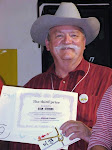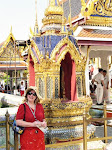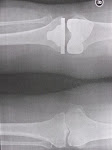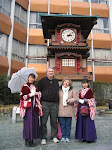Obon is the Japanese Buddhist holiday dedicated to honoring the spirits of ancestors who have passed on to the next realm. In Japan, the portal between the world of the living and that of the non-living is a hazy one. Many Japanese believe that their ancestors visit this world frequently – of their own accord or when summoned – to counsel, comfort, and just generally keep on eye on things. Thus, reunion with family ghosts is a cause for comfort and celebration. Each summer these spirits return for three days to watch over and protect those still living, and to influence the course of events for their living relatives. This holiday is traditionally held during mid-August in this area of Japan, and most businesses are closed for at least a week. As most Japanese no longer live near their family haka, or tomb, families return to their ancestral home to visit and participate in the local Obon celebrations, which means increased travel all over Japan. (This is why we had to return to Japan before August!)
Obon is an abbreviation of Urabon, a transliteration of Ullambana, the Sanskrit word which means to hang upside down in Hell. According to Shingon Buddhist International Institute, the ritual of Obon is conducted in accordance with the teachings of Sakymuni Buddha. The story is told that a disciple of the Buddha, Mokuren Sonja, used his supernatural powers to look upon his mother, who had passed away. Through his vision, he could see that his mother was enduring intense suffering while in the Realm of Hungry Ghosts. In an effort to save her from the torture she was experiencing, he was instructed by the Buddha to provide a large feast for the past seven generations of the dead in mid-summer. Mokuren carried out the Buddha’s instruction and his mother was set free. Mokuren Sonuja was so relieved and grateful for his mother’s release from her ordeal that he danced joyously in celebration. His dance became known as the Bon Odori dance. This dance is performed as a reminder of the respect and thankfulness one should feel toward ancestors who have passed into the next life. The dance also serves to welcome back the spirits of the dead, and to celebrate their being among the living once again. Outfitted in the light, summer cotton kimono known as yukata, Obon festival participants dance around a tall wooden structure, called yagura, built especially for the festival. Taiko drummers provide the rhythm for the dancers, often accompanied by high-pitched bamboo flutes. The dance is rhythmic and repetitive, with each movement having a special significance, representing everyday activities common to most agricultural societies, such as digging, planting, harvesting, washing, & threshing.
Another ritual performed during the festival is to set vegetables, fruit, and beverages such as tea, beer, or sake out for the spirits to feast upon, and especially foods that the deceased were known to enjoy in life. Bright paper lanterns are hung at the haka, which has been thoroughly cleaned and specially decorated for the occasion with fresh water and flowers. On the third day of the festival, lanterns are lit at the haka, and more lanterns set afloat on rivers, lakes and seas to light the ancestors’ way back to the other world. Haka are cleaned once again, and those who have traveled from afar, bid farewell to their ancestral homes and families to return to the everyday world of school and work. The end of Obon traditionally marks the end of summer, despite the oppressive weather that is still in evidence, especially in the Iwakuni area.
--Excerpted from Obon: The Ancestors Return by MCCS Preview Staff, Aug 2005 issue.
Tuesday, September 13, 2005
Subscribe to:
Post Comments (Atom)






















No comments:
Post a Comment